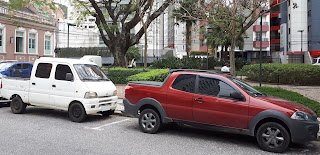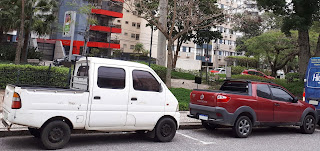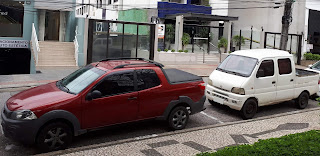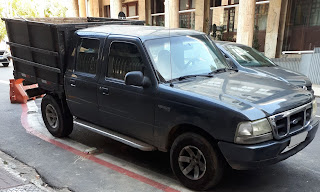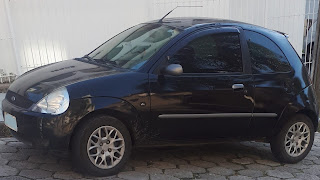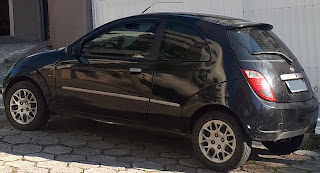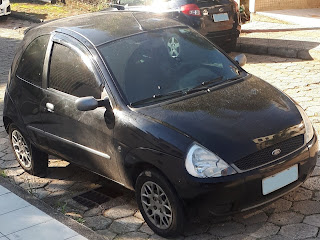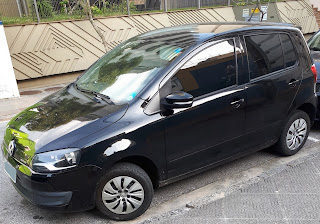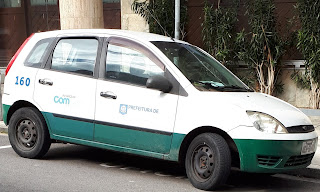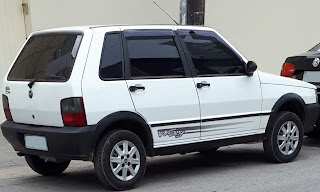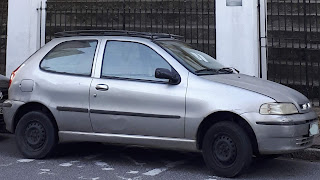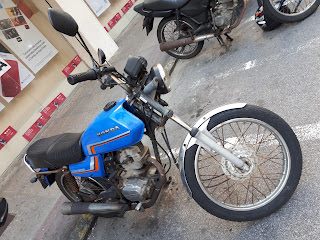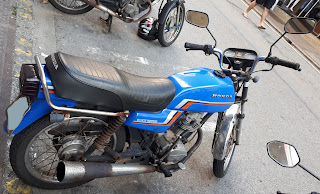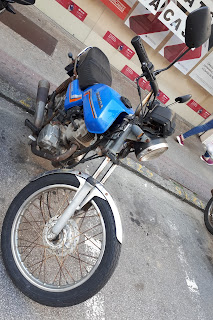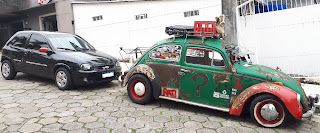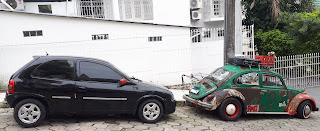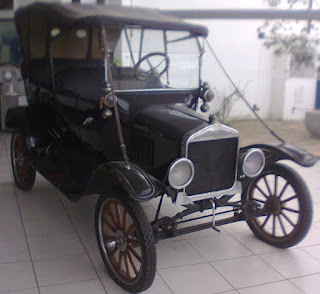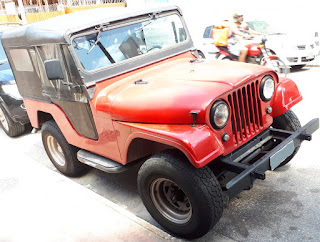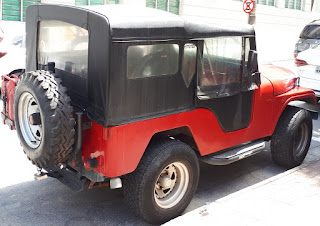Sunday, December 26, 2021
Brazilian vs. Chinese: what's the best approach to the small bakkie?
In favour of the car-based designs more sought after in Brazil, which despite being mostly based upon a front-wheel drive unibody such as the Fiat Strada end up resembling an Australian coupé-utility, there is usually a better overall performance due to the fitment of engines better suited to deal with the GVWR, in contrast to the often underpowered copies of some random outdated Japanese engine and extremely low gearing often found on those Chinese copies of the Suzuki Carry. While the unibody doesn't render a Brazilian coupé-utility so easy to replace the stock rear tray for a task-specific bodywork compared to a body-on-frame, and the front-wheel drive is more affected by changes to the weight bias when loaded, the Fiat Strada often leads the commercial vehicle sales ranking in Brazil, not only among urban buyers who might prefer a smoothier ride but also for agribusiness-related duties. In the end, while commercial operators may become attracted to the cheap Chinese Suzuki copy at a first glance, the Brazilian coupé-utility is more cost-effective.
Tuesday, December 21, 2021
Spotted on the wild: dedicated-ethanol Brazilian Chevrolet Monza
Saturday, December 18, 2021
5 cars other than air-cooled Volkswagens or Porsches that could be interesting to adapt an Australian Radial Motion engine
1 - Ford Ranger (Americas model until 2011): as some trims of the Radial Motion engine outperform the 2.3L Duratec 4-cyl which was the base-engine for this model, even though it has a slightly smaller displacement and a pushrod valvetrain, it already sounds interesting enough to justify. The lower weight is also interesting, considering the gasoline-powered versions had a lower payload than the turbodiesel versions made in Argentina, so the weight bias would be improved while unloaded without detrimental effects while loaded;
2 - Chevrolet Opala: the Brazilian equivalent to the Opel Rekord C/Commodore A, was fitted with the 2.5L Chevrolet 153 engine (later 151) on its 4-cylinder versions, while the 6-cylinder had either a 3.8L 230 or a 4.1L 250 engine according to the model-year. Even though it's smaller than any engine fitted to the Opala and the 6-cylinder Opel CIH engines fitted to the Commodore, there are some versions of the Radial Motion capable of outperforming them all in stock form. Liquid-cooling might sound as a quite obvious way to go, but I must confess it would also be quite tempting to try an air-cooled;
3 - early Suzuki Grand Vitara: even the 2.5L H25A V6 can be outperformed by some versions of the Radial Motion engine, let alone the much more usual 4-cylinder 2.0L J20. A lower-weight and shorter engine such as the Radial Motion may also actually benefit off-road performance;
4 - Lada Niva: engine swaps are quite common for this model in my country, with Volkswagen EA827 engines being the most common option. As the Radial Motion is offered with a Volkswagen bolt pattern it might be another straightforward adaptation too;
5 - Alfa Romeo Giulia GTV: an Italian beauty which stock engine is a piece of mechanical artwork, but it would still be tempting to go one step further. Well, considering the carburettor-fed versions of the Radial Motion might at first seem more complicated due to having one more carburettor, it's also worth to remind it won't require any timing chain replacement as the Alfa Romeo "Nord" Twin Cam engine would, the Alfa Romeo had dual-barrel carburettors which are far from dumbproof. It's also interesting to compare the electronic fuel injections of the Radial Motion to the SPICA mechanical fuel injection which used to be fitted to US-spec Alfa Romeo models.
Saturday, December 11, 2021
Argentinian-made '02 Ford Ranger with factory crew-cab and artesanal wooden high-dropside flatbed
Saturday, December 04, 2021
Why could the Ford Ka Mk.1 be considered suitable to the role of a VW Beetle replacement?
Naturally some technical differences such as relying on a front-mounted transverse inline-4 engine and front-wheel drive, which became the standard for most economy-cars in the '90s along the McPherson suspension up front and a rear torsion beam, highlight much of the changes within the motor industry and the focus on "manufacturability" increasing the parts commonality with other mainstream models for better economics of scale. Unlike the Beetle which turned out to be quite unconventional according to the standards of small cars at its release, and became a category of its own, the Ka followed a quite conservative approach considering the market conditions during its development and production cycles. So, despite the obvious technical aspects and marketing circumstances which each model was subjected at their respective times, it's not totally out of question to consider the Ford Ka Mk.1 one of the possible answers to the search for an eventual Beetle replacement.
Friday, November 26, 2021
PQ24-based Fox, probably the most underappreciated Volkswagen ever
More capable of actually meeting the requirements for a small family car than the Up, maybe the Fox is even more up to the task (no pun intended again) of fulfilling the role of a Beetle replacement, despite its Euro-spec variants being only 4-seater in contrast to the 5-seater layout of the versions sold in Latin America. Its relatively long production run with fewer minor upgrades, and being based upon the same underpinnings of some mainstream European-designed model also prompts to a comparison between the Fox and the Beetle-derived Brasília, which were both Brazilian-specific designs with only a minor international availability. Relying on already-proven underpinnings, and being suitable to the fitment of up-to-date engines such as the 3-cyl flexfuel 1.0L fitted to the 2014 model-year BlueMotion version, the Fox was a smarter design than its presence more concentrated on a handful of so-called "emerging markets" in Latin America could suggest.
Monday, November 22, 2021
Brazilian Honda CG 160 modded similar to a Brat-Style
Friday, November 19, 2021
3 cars made in Brazil which actually surprised me for never having ever featured a pushrod engine
In a country like Brazil, often pointed out as a harsh environment for the most up-to-date car tech due to reckless car owners who don't really seem to care about preventive maintenance, one aspect which does often amaze me is how some so-called "people's cars" never really featured some much simpler engine designs. Sometimes there is a good reason to take benefit from the economics of scale manufacturing a very same engine which can cater both to a no-frills small car and to something else one class above, yet the higher degree of neglect entry-level models often face may justify a more austere powertrain, such as an OHV (overhead-valve) engine, a.k.a. cam-in-block or "pushrod" engine. Among so many econoboxes which had ever been available in Brazil at some point, at least 3 do surprise me enough to justify being listed as a car which could've eventually benefitted from a pushrod engine:
1 - Ford Fiesta Mk.5: this was the first generation of the Fiesta to feature only engines with either a single or double overhead cams, benefitting from the development of the Zetec-Rocam engine range which relied on a chain-driven single overhead cam and had only 2 valves per cylinder. Even though it would most likely be out of question to start manufacturing the Endura-E 1.0L and 1.3L engines locally, Ford had previously made under license from Renault some derivatives of the Cléon-Fonte engine, with the displacement ranging from 1.0L to 1.6L exactly like the Zetec-Rocam. Sure the higher performance and more rev-happy nature of the Zetec-Rocam were more in accordance to the expectations of the average Brazilian budget-conscious car buyer during the production run of the Fiesta Mk.5 and its local facelifted versions, yet its sealed timing chain can be quite bothersome to replace once the engine gets a full overhaul;2 - Brazilian Fiat Uno: unlike its European counterpart which had featured 899cc and 903cc versions of the 100-series engine, the Brazilian model resorted to a belt-driven OHC derivative of the 124-series and later to the FIRE engine. The early Fiasa engine was often plagued by timing belt ruptures and, due to its interference design, serious damage can occur if a valve still open gets hit by a piston. As a chain-driven OHV engine would be less prone to this issue, which plagued so many Fiats in Brazil until the FIRE engine already developed from scratch with an OHC valvetrain had a properly-designed belt tensioner was released locally, quite lately compared to the European market by the way, and in some neighboring countries were also offered versions of the European Fiat Uno still featuring the 100-series 903cc engine alongside its Brazilian counterparts, seems like a pushrod engine would not be so out of question regarding regional operating conditions;
3 - Fiat Palio: meant as a replacement to the Uno in Latin America, parts of Africa and Eastern Europe, having also resorted to the 124-series OHC derivative and the 128-series, also featuring the FIRE which became prevalent after the first facelift, the same harsh environmental conditions and often a precarious maintenance would justify an OHV engine. Even though the FIRE engine has often been regarded as a quite dumbproof engine, a chain-driven OHV valvetrain is often still more suitable to harsher operating conditions.
Monday, November 08, 2021
'83 Honda CG 125 on the wild
Even though it's clearly not babied, with some amount of rust clearly visible to an extention that would make it fail a roadworthiness inspection had such matter been effectively taken seriously in Brazil, the period-accurate graphics in such an utilitarian motorcycle that may eventually been subjected to harsher operating conditions is noteworthy. Seemingly quite easy to restore to a fully period-correct appearance, this '83 Honda CG 125 has its nostalgia appeal in a moment when there is a growing appreciation for its historical value, yet remaining somewhat practical instead for daily riding instead of being turned into a trailer queen to be only displayed at antique car and motorcycle events. And truth be told, its austere appearance remains quite pleasurable to see.
Monday, November 01, 2021
Brazilian replica of a Ford F-650 "super pick-up"
Monday, October 25, 2021
Color-matching tail lights: a reminiscence from mid-'90s
Monday, October 04, 2021
Dina D9400, a Mexican rebadged International 9400
Friday, October 01, 2021
Volkswagen Beetle and Opel Corsa B: two remarkable generations of "people's car" in contrast
Another small car which had a noticeable role at the time of its release both in Brazil and Mexico, and a fierce competitor to the Beetle by the way, the Opel Corsa B was rebadged in Brazil as Chevrolet Corsa and in Mexico initially as Chevrolet Chevy. Even though its technique was quite austere in accordance to the European perspective in '93 when it arrived in Mexico initially imported from Spain and in '94 at the beginning of local production in Brazil, this model is noticeable for undeniably turning the "people's car" segment all-around, as the first real contender to the Mexican Beetle locally called "Vocho", and in Brazil its relevance as a world-class small car going as far as pioneering the electronic fuel injection for entry-level models. Eventually the Opel Corsa B may not reach a similar cult status as the Beetle, yet it had a comparable role in a time when the "people's car" concept in Brazil had already been highlighting the preferences of a more city-oriented customer base.
Monday, September 27, 2021
5 cars I would eventually consider to fit a souped-up reproduction of a Ford Model T engine
1 - Jeep CJ-5: possibly the closest to an austerity comparable to the Ford Model T around '83 in Brazil and the United States, the CJ-5 had many different engine options throughout its production run which took place in many countries, and at least in Argentina it featured a 2.5L Kaiser Continental L-151 side-valve engine until '78 with option for either a 6.86:1 low compression ratio or a 7.3:1 standard. As most of the high-compression cylinder heads meant to the Model T feature a 6:1 compression ratio, and some go even further into 8:1 which could even withstand to a CNG conversion better than stock Argentinian engines, this would already be a good starting point in favor of what could be seen at first as "outdated". Sure other improvements would be desirable, maybe a stroker crankshaft and a higher-lift camshaft, and as far as off-road performance goes it's worth to remind the dual-range transfer case featured on a 4WD Jeep, which on low-range may be comparable to the Ruckstell 2-speed axle which used to be offered as an aftermarket improvement to the cross-country abilities of the Ford Model T;
2 - Ford Maverick: the Brazilian 6-cylinder versions were fitted with the Willys Hurricane engine instead of the same Thriftpower Six of their American counterparts, because Ford was definitely out of pace when it comes to engine offerings in Brazil. Even though a Model T engine would be very unlikely to become an actual improvement, neither stock or with some old-school performance upgrades developed around the earlier days of hot-rodding, it would be quite tempting to do in jest for Ford and the management of its Brazilian branch;
4 - Gurgel Carajás: this Brazilian SUV from the '80s resorted to a Volkswagen powertrain, adjusted to allow the fitment of the engine at the front with a rear transaxle. Considering the Ford Model T used to be highlighted for its off-road performance even though it also only resorted to rear-wheel drive, maybe an upgraded copy of its engine would be interesting to see fitted to a Gurgel Carajás, even though it had a milder off-road capability compared to its smaller rear-engined predecessors;
5 - Simca Vedette/Chambord: actually based on Ford designs, even featuring versions of the Flathead V8, maybe this is among the least strange options to try fitting an upgraded Model T engine. As the V8 fitted to the Simca Vedette ranged from 2.2L to 2.4L displacement, and the bigger variant being the only one fitted during the extended production run of the Simca Chambord in Brazil, an attempt to replace it would be presumably met with fewer objections than a similar attempt considering the larger variants of the Ford Flathead V8 which were featured on full-size Ford until '53 (or '54 in Australia). Definitely it would be worth to increase the compression ratio and a higher-lift camshaft if a Model T engine could be swapped into a Simca Chambord, eventually reaching power ratings closer to the 2.2L Aquillon V8, yet at a much lower RPM.
